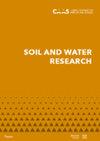Potentially toxic metals and metalloids in surface water intended for human consumption and other uses in the Mantaro River watershed, Peru
IF 1.7
4区 农林科学
Q4 SOIL SCIENCE
引用次数: 10
Abstract
The concentration of Cu, Fe, Pb, Zn and As in the surface water intended for human consumption and other uses in the Mantaro River basin were analysed using multivariate methods. The water samples were collected from seven water bodies in the Junín region in June 2019, in the low discharge period. In each body of water, a sector with six sampling sites was established. The Cu, Fe, Pb, Zn and As contents were determined by the flame atomic absorption spectrophotometry method. The correlation analysis revealed positive and significant correlations (P < 0.05) for the Zn/Pb, Pb/Fe and Zn/Fe pairs with a good association, higher than 0.80 and for the Pb/Cu, Fe/Cu, As/Pb and As/Zn pairs a weak degree of association (P < 0.05). The analysis of the main components showed three components with their own values > 1. The hierarchical grouping analysis classified the evaluated water bodies into three groups according to the concentration of the Cu, Fe, Pb, Zn and As. The high concentrations of heavy metals and arsenic recorded in the CIMIRM and MERIS irrigation channels reveal that the Mantaro River continues to be a sink for mine wastewater discharges and runoff from mining liabilities at the headwaters of the Mantaro basin. It is, therefore, necessary to implement urgent management policies to control and reduce the levels of contamination by potentially toxic metals and metalloids in the Mantaro River.秘鲁曼塔罗河流域供人类消费和其他用途的地表水中的潜在有毒金属和类金属
采用多变量分析方法对曼塔罗河流域供人类饮用和其他用途的地表水中Cu、Fe、Pb、Zn和As的浓度进行了分析。2019年6月,在低排放期,采集Junín地区7个水体的水样。在每个水体中,建立了一个有六个采样点的部门。采用火焰原子吸收分光光度法测定了铜、铁、铅、锌和砷的含量。相关分析显示,Zn/Pb、Pb/Fe和Zn/Fe对呈显著正相关(P < 0.05),相关性较好,均大于0.80;Pb/Cu、Fe/Cu、As/Pb和As/Zn对呈弱相关(P < 0.05)。主成分分析显示,3个成分各有其值> 1。根据Cu、Fe、Pb、Zn、As的浓度将评价水体分为3类。在CIMIRM和MERIS灌溉渠中记录的高浓度重金属和砷表明,曼塔罗河仍然是曼塔罗盆地源头的矿山废水排放和采矿责任径流的汇合点。因此,有必要实施紧急管理政策,以控制和减少曼塔罗河中潜在有毒金属和类金属的污染水平。
本文章由计算机程序翻译,如有差异,请以英文原文为准。
求助全文
约1分钟内获得全文
求助全文
来源期刊

Soil and Water Research
Water resources, Soil Science, Agriculture-WATER RESOURCES
CiteScore
4.60
自引率
0.00%
发文量
26
审稿时长
>12 weeks
期刊介绍:
An international peer-reviewed journal published under the auspices of the Czech Academy of Agricultural Sciences and financed by the Ministry of Agriculture of the Czech Republic. Published since 2006.
Thematic: original papers, short communications and critical reviews from all fields of science and engineering related to soil and water and their interactions in natural and man-modified landscapes, with a particular focus on agricultural land use. The fields encompassed include, but are not limited to, the basic and applied soil science, soil hydrology, irrigation and drainage of lands, hydrology, management and revitalisation of small water streams and small water reservoirs, including fishponds, soil erosion research and control, drought and flood control, wetland restoration and protection, surface and ground water protection in therms of their quantity and quality.
 求助内容:
求助内容: 应助结果提醒方式:
应助结果提醒方式:


